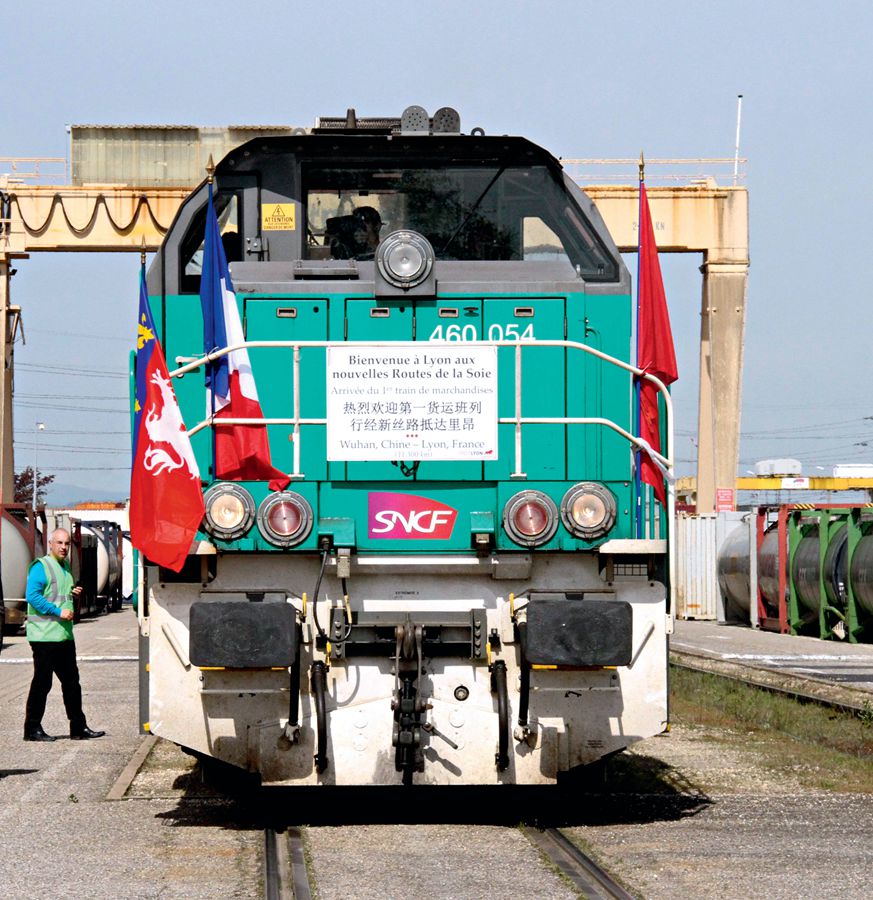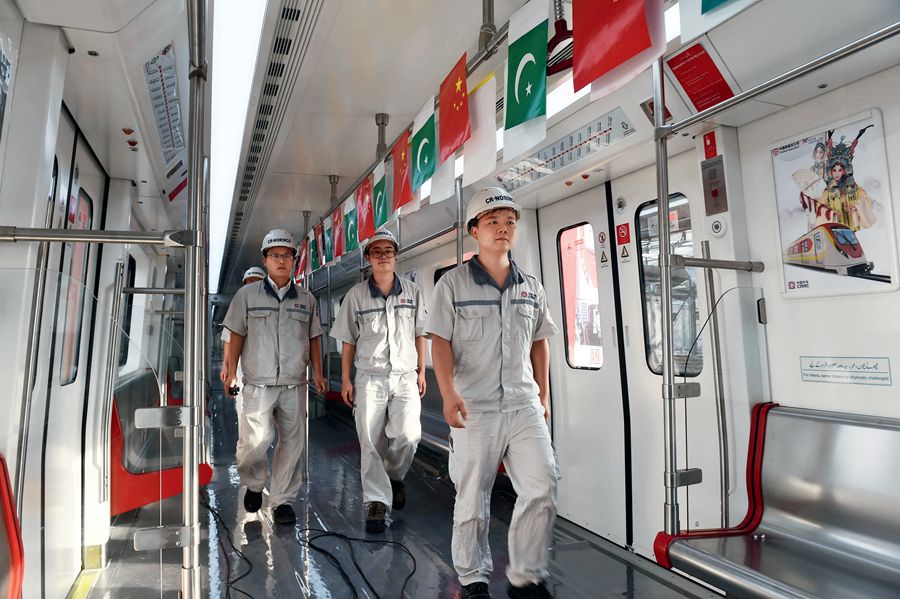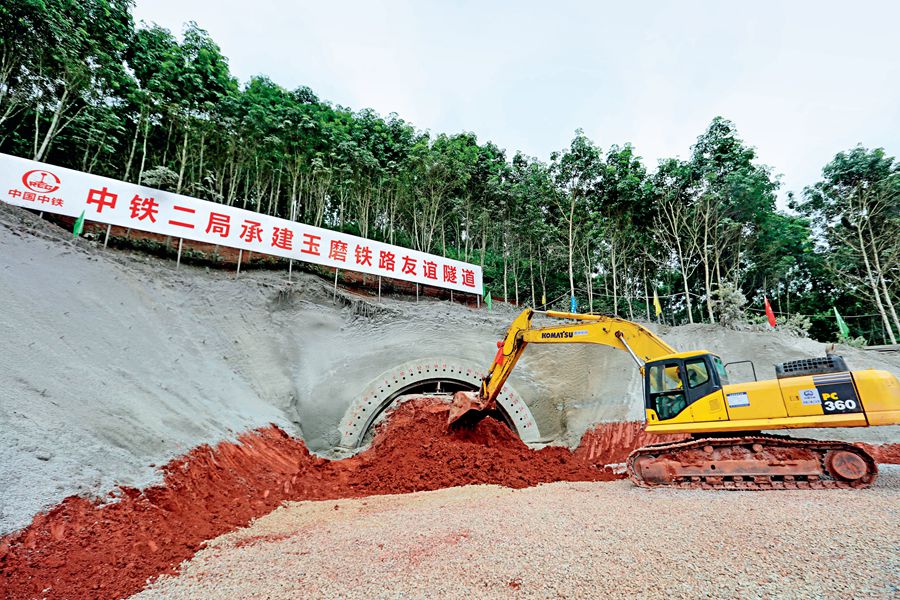OVER the last five years, the accomplishments of the construction of the Belt and Road have exceeded expectations. The Belt and Road Initiative has become a hot topic in the international community.

On April 21, 2016, a train from Wuhan, China, arrives at the Venissieux Freight Station in Lyon, France, after a 15-day trip from Asia to Europe. This is the maiden trip of a China-Europe train to France.
This great project was first proposed by China, but the opportunities and achievements are shared by the world. Against the backdrop of trade protectionism, unilateralism, isolationism, and other virulent trends, the open global economy and the multilateral trading system have suffered tremendously. China’s promotion of the Belt and Road undertaking embodies China’s commitment to its international responsibility as a responsible country, highlighting its international significance, and the values of the times.
First, the growth of the world economy has entered a “new mediocre” era, but the Belt and Road Initiative can lead to a new round of energized productivity for the Afro-Eurasian region to advance global economic development. The term “new mediocre” was proposed by Christine Lagarde, chief of the International Monetary Fund, to describe the current state of the world economy and the development prospects in the years to come. At present, the recovery of the world economy remains slow and uneven, global economic growth lacks momentum, and the new round of technological and industrial revolution is still at an embryonic stage. There is no substantial progress in key innovation of technologies and business models. In the short term, it seems difficult to form a new, strong point of economic growth.

On May 31, 2017, an excited passenger displays his ticket on the inauguration of the standard railroad from Mombasa to Nairobi at the Nairobi Terminal, Kenya.
Economic globalization and reverse globalization coexist simultaneously: to promote economic recovery, many countries resort to trade protectionism, increasing trade frictions. The previous round of economic globalization has failed to achieve general, balanced, and inclusive development, and has instead widened the gap between the rich and the poor and led to a shift in class structures.
Many countries along the Belt and Road, which have been ignored and neglected for many years by a large number of developed countries and multinational businesses, consider the Belt and Road Initiative as a historic opportunity for shaking off poverty and achieving development. As China’s infrastructure projects and industrial investments spread to these developing countries, they and their people will reap the benefits. The initiative will help achieve integration and common development in Europe, Asia, and Africa, and promote modernization of global infrastructure to build the foundation for a sustainable global economy.

On the afternoon of October 8, 2017, in Lahore, the grand reception ceremony for metro line railroad cars from China is underway.
Secondly, from the point of view of the international mechanisms, there is a serious deficit in global governance. The Belt and Road Initiative is China’s viable solution for improving global governance. At present, the setback in economic globalization, the fragmentation of regional cooperation, climate change, migration, terrorism, and other thorny issues of global governance are becoming increasingly dire. The internal problems of some countries are spilling over their borders, and the existing international mechanisms are finding it difficult to adapt.
Faced with these weaknesses, reform of the international system falters and sputters. The G20 has played an important role in overcoming the international financial crisis, but in the end it is mostly an expedient arrangement to deal with the crisis. There is no clear plan so far for the G20 to integrate with existing international mechanisms to increase its effectiveness. Issues of global and regional governance, such as international exchange rate negotiation mechanisms, international capital flows, regulatory mechanisms for financial derivative instrument, as well as challenges to multilateral trade rules, need to be addressed.

On June 22, 2016, construction begins on the Friendship Tunnel of the China-Laos Railway.
Through the Belt and Road Initiative, China actively promotes a new globalization mechanism, and gives a modern version of globalization in Asia-Pacific as well as the rest of the world. The country has become the champion of free trade and the defender of international rules. As the second largest economy in the world, the leading industrial goods exporter, and the largest trading partner of more than 120 countries, China has given new impetus to globalization and global governance through the Belt and Road Initiative.
Third, from the point of view of the countries concerned, the Belt and Road Initiative helps to promote coordinated development between different regions and countries. Different from the traditional free trade zones and customs unions, the initiative is open and inclusive. It focuses on integration with existing international mechanisms and national development strategies. It does not presuppose preconditions, pursue unilateral institutional arrangements, or seek to satisfy its own interests at the expenses of others’. The Belt and Road Initiative emphasizes the diversity and complementarity of countries that cooperate, and ensures the satisfaction and participation of all parties.
At the international level, the United Nations Development Programme, the United Nations Industrial Development Organization, the United Nations Human Settlements Program, the International Civil Aviation Organization, the International Maritime Organization, the World Health Organization, all seek concord with the initiative. The United Nations General Assembly and the Security Council have both included the Belt and Road in relevant resolutions and development programs.
At the regional level, the Asia-Pacific Economic Cooperation, the Eurasian Economic Union, the Shanghai Cooperation Organization, the Association of Southeast Asian Nations, and the European Union have all spliced their interconnectivity and investment plans with the initiative.
At the national level, many countries such as Kazakhstan, Mongolia, Vietnam, Indonesia, and Turkey have begun to link their national development plans to the Belt and Road. Under this initiative, all participating countries are equal, and the results of their cooperation are meant to benefit all involved. It focuses on building economic links of cooperation between different regions, countries, and fields, promoting development through cooperation, as well as promoting mutual benefits through communication.
The practices of the last five years show that the Belt and Road Initiative is not a “geopolitical strategy” as it has been slandered by some Western think tanks, and it does not seek to expand the Chinese “sphere of influence” nor export the “Chinese model.” With its own experience and practice, China actively promotes the development of the world economy in a more sustainable direction.
JIN XIN is director of China Center for Contemporary World Studies and secretary general of the Belt and Road International Think Tank Cooperation Alliance.



